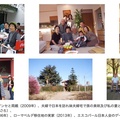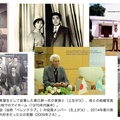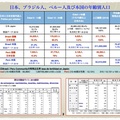Located 50 kilometers north of Argentina’s capital city, Buenos Aires, Escobar is known as “the city of flowers.”1 A flower festival is held in October every year, where they showcase new breed varieties from in and out of the country and have a parade with floats covered with flowers such as carnations, decorated by a number of local groups including the Escobar Nihonjinkai (Japanese Association). They also host a beauty pageant for the flower festival.2 As this two-week festival attracts some hundreds of thousands of people from all around the country, the event has become the city’s big business, greatly anticipated each year by merchandise shops as they get ready for it. Escobar also boasts a compact yet authentic Japanese garden, which stands as an important attraction for the local community.3
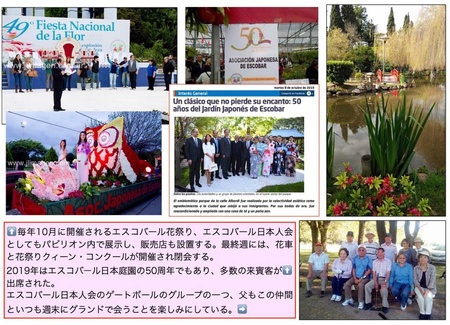
The floriculture in Escobar is said to owe its success to Kuhei Gashu, an agriculture engineer from Hokkaido who specialized in flower farming. He came to the place in 1929. Gashu arrived in Argentina from neighboring country Chile, crossing the Andes in 1918. He first stayed in Mendoza, famously known for its winery and a few years later opened a shop in Belgrano in Buenos Aires where he sold flowers and indoor house plants. Gashu had been looking for some good places for flower cultivation and moved to Escobar, as he came to the conclusion that the land of Escobar was the best with its fertile soil at a high altitude.4 He devoted himself to flower farming with some of the well-known figures in the local community – Koike, Hisaki, Honda, Nakanishi, Watanabe, and others. Not surprisingly, Escobar became the biggest site of floriculture in Argentina.
Escobar already had its railroads at the end of the 19th century. This enabled the workers in the floriculture industry to send their freshly cut flowers in large baskets on a train to Buenos Aires. In 1942, together with Italian and Portuguese immigrants, Japanese immigrants established the floriculture business union. With an exponential increase in the supply of flowers after the war, some started to work as carriers exclusively for transporting flowers. The Japanese pioneers in the industry like Gashu tried to interact and work with peers in the suburban area of Buenos Aires by establishing Japanese committees, Japanese language schools, business unions, workshops, publicity organizations, and other groups.
My father moved from Buenos Aires to Escobar after his marriage in 1961. His decision to move was triggered by Gashu’s wife Shizuko, as he’d had an opportunity to hear her speak in Japan. Around 1956, at the National Institute for Agricultural Technology of the current Ministry of Agriculture, Forestry, and Fisheries, Shizuko gave a speech about overseas immigration and the greatness and potential of Argentina to young trainees. My father, who was having his training at the institute at the time, was fascinated by her speech. With the recommendation of faculty members, he moved to Buenos Aires in 1957 as one of the postwar, first-year apprentices of the Ministry of Foreign Affairs’ overseas agriculture training program and came to Escobar four years later. He says that he owes a debt of gratitude to Hosokawa and Hirai, who’d already had their business in flower farming and Gashu, too, for his guidance and support in the early days of settlement.5
I myself have also received much support from the Gashu family, and I can’t thank them enough. During my middle school and high school years, I had opportunities to learn from Teresa, Kuhei’s second daughter who taught geography. Since I came to Japan as an international student, I have been treated kindly by Irene Gashu,6 Kuhei’s grandchild who currently resides in Gifu Prefecture and works as a lawyer and photographer. Also, Kuhei’s other grandchild Gustavo is my junior, who attended the same school as I did for middle school and high school years. We have kept in touch to this day.7
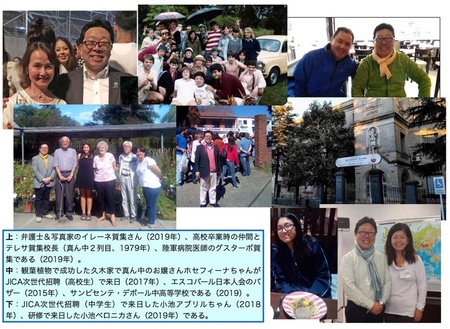
By 1962, the year I was born, Escobar had already thrived as a town, and the Nikkei community had developed, too, with an estimate of 400 Nikkei people in 140 households. Nikkei organizations such as Belén Club (which later became the Japanese committee) and Japanese language schools had also been well taken care of. When I started elementary school, about one-third of my classmates were Nikkei. At a Japanese language school which was a private cram school, as live-in teachers, the Kawano couple taught us Japanese and kanji every day. Having events like school plays and sports days, I received semi-bilingual education for six years at elementary school.8
Also, back in those days, Nikkei people had a great reputation, as they had interacted more with local communities. Though there is no record of Nikkei people running for office in local politics, Kuhei’s eldest son Ángel Kiyoshi served a number of roles in the city of Escobar and even became a legislator.9 His second son Alberto, who is an accountant now, has been successively holding the post of Economic Counselor at the Argentine Embassy in Tokyo.
As Escobar had a large number of Nikkei with high fluency in Japanese, many Nikkei in Escobar were hired by Japanese trading companies and manufacturers working on the electrification of railroads in the suburban area of Buenos Aires in the 1970s.10 During the 1990s, there were a number of Nikkei engineers and accountants who got jobs at Toyota plants.11 As time passed, the community has been handed over to next the generations, and today the operation of Nikkei organizations is handled by the Sansei, taking it over from the Nisei. Also, as more and more people are getting married with non-Nikkei, the general proficiency of the Japanese language has gone down.
Yet in recent years we see more and more young Nikkei, those who belong to the third generation and beyond, come to Japan for studying or for JICA training. My work involves briefing for and accepting Nikkei trainees at JICA Yokohama, and I sometimes meet Nikkei people from my hometown, Escobar. I have met a grandchild of an acquaintance. It was such a delightful experience to meet the grandchild and the great-grandchild of Koike, one of the pioneers of the Nikkei community in Escobar, and Hisaki’s great-grandchild some years ago.
Today, the city of Escobar has a population of 55,000, and the number goes up to 220,000 if we count all in the county. It has now become quite a big community in the capital area as well. As for the Nikkei community, according to the recent survey, there are about 300 Nikkei, 50 of whom are Issei, 144 Nisei, 149 Sansei, 84 Yonsei, and 3 Gosei.12 Some of the Nisei and Sansei work in the flower and vegetable cultivation business, yet the majority seems to be involved in growing indoor house plants.
In November 2019, in commemoration of Kuhei Gashu’s arrival, a celebratory gathering was held at the meeting hall of Escobar Nihonjinkai (Japanese committee) for the 90th anniversary of Japanese immigration. The event was attended by many Nikkei, including some guests and those who had great contributions to the community, and it was officially recognized by the city and the province.13 From the other side of the earth, I paid great respect to Kuhei and other pioneers who have turned Escobar into the city of flowers and felt grateful once again for having been born and raised there, surrounded by many supportive people.
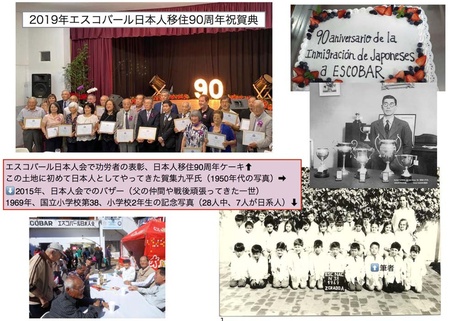
Notes:
1. Canio Nicolás Iacouzzi (Rotary Club Escobar), La Fiesta de la Flor, escobarsite, 1983.5.10
- Fiesta de la Flor (Official site)
2. The title of the first ever flower festival queen was given to a Nisei woman named Estelle Yoshimiya.
3. Ciro Jacuzzi, Un clásico que no pierde su encanto: 50 años del Jardín Japonés de Escobar, El Día de Escobar, 2019.10.08
- Qué ver en Escobar (Escobar turismo)
The designing and construction of the Japanese garden in Escobar was led by Yasuo Inomata who had graduated from the Tokyo University of Agriculture and moved to Argentina in 1966, and the garden was opened to public on October 4, 1969. At its 50th anniversary in 2019, the representatives of the provincial government including the city mayor, Ambassador Nakamae, and Consul Furukawa (both residing in Argentina), Roberto Hirose the chairperson of the flower festival association and Inomata who once again was given recognition by the city, all attended the ceremonial. This garden is maintained by the city as it was donated to the city authorities by the local Nikkei community as a token of gratitude to the Argentine community, yet Nikkei people including Inomata have always been part of the preservation of plants in the garden.
- “El primer Jardín Japonés” (Escobar Web TV)
4. Kuhei Gashu not only chose Escobar as the ultimate place for flower cultivation and made a success of it there, but he also put effort into fostering next generations and starting various organizations on which he was conferred a decoration by the Japanese government. He passed away at age 90 in 1987.
5. Edited by Kagawa Kenjinkai in Argentina, “Talks of the Taisho-born young – a round-table talk of young males in the northern suburban area of Buenos Aires City (Page 3 – 44), “The memorial issue in celebration of the 35th anniversary of Kagawa Kenjinkai,” 2005.
6. Irene is the daughter of Kuhei’s second son Alberto.
7. Gustavo is the son of Kuhei’s eldest son, Ángel Kiyoshi. He currently works in the ICU department at the Argentine Army’s Central Military Medical Hospital as one of the doctors on the front lines of fighting COVID-19.
8. Before Kuhei Gashu got himself settled in Escobar, there were some people who held pride in their intellectual abilities among other Japanese who had moved to Buenos Aires, and there seems to have been an intense discussion on the necessity of teaching the Japanese language to Nikkei offspring. Kuhei and his friends Keiya Komatsu and Fujitaro Arimizu were all for it. Japan’s political measures on the colonization of Asia and the conflict of ideology back in the days apparently affected those who had left the country and settled in other places in the world as well. As the Japanese language education for young generations had always been deemed highly important in Escobar, many of the Nisei and Sansei generations had opportunities to study in Japan and became a bridge between the two countries. Source: Noriko Mutsuki, “Early Day of Showa Japanese Society in Argentina – The World of Buenos Aires (weekly published),” Annual report on the studies of Latin America Nº29, 2009.
9. Angel Kiyoshi Gashu, under the postwar Perón administration, successively served the roles of Director at the Legislation Bureau of Executive Office, Head of the Statistics Bureau, national legislator (his term ended in 5 months due to the military coup d’état in 1955), Auditor at the Chamber of Commerce of Buenos Aires, and a consultant for companies in and out of the country. He passed away at age 59, still young, on August 2, 1985.
10. Enterprises such as Marubeni and Hitachi took part in the electrification of railroads, and NEC played a big role in the modernization of the telecommunications business.
11. Toyota Argentina S.A. in Zárate is located 40 kilometers north of Escobar. This plant exports 30,000 units annually and earns 800 million dollars as foreign sourced income. Since its launch 23 years ago (in 1997), it has manufactured a total of 1 million units.
- “Toyota alcanzó el millón de unidades exportadas desde su planta de Zárate”, ámbito 2020.8.3.
12. The survey was conducted in September 2019 as part of the project in commemoration of the 90th anniversary of Japanese immigration to Escobar, and the actual number of people living in Escobar is 285. The number goes up to 430 if we include those residing in other cities and places in and out of the country. From 1948 to 1949, a great number of Japanese people moved to Escobar from Paraguay, and the immigration continued until 1970 with people coming from other neighboring countries and from Japan as well. In 1990, they were able to keep track of many young Nikkei people going to Japan as migrant workers. Source: Escobar Nihonjinkai, information provided by Humberto Koike, one of the people in charge (October 14, 2020).
13. The event was reported in the provincial government media.
“Escobar: 90 años de la colectividad japonesa”, Canal Provincial Noticias, 2019.11.22
Asociación Japonesa de Escobar (Facebook)
© 2020 Alberto Matsumoto


